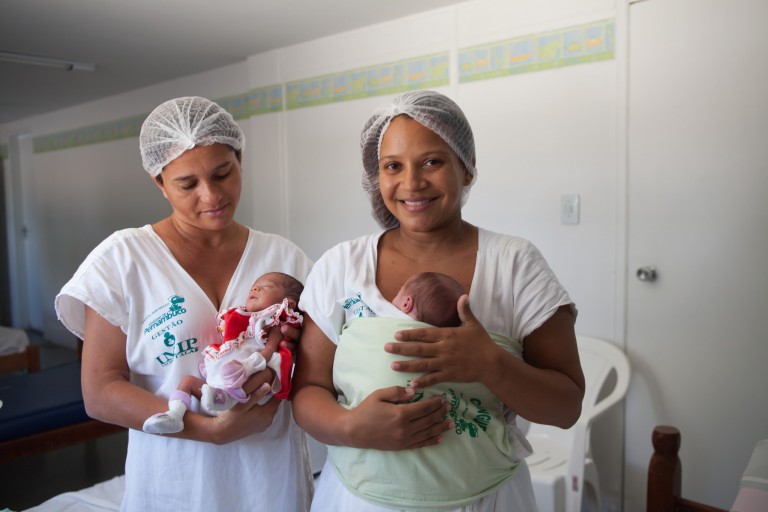 Writen by:
Writen by:
Professor Mary J Renfrew RM PhD FRSE
Director, Mother and Infant Research Unit
University of Dundee
UK
m.renfrew@dundee.ac.uk
The Lancet Series on Breastfeeding has clearly laid out the direction of travel for policy and practice to improve breastfeeding rates worldwide (Victora et al 2016, Rollins et al 2016). Important knowledge gaps remain, however, on the scale of the impact of the widespread use of breastmilk substitutes for the most vulnerable infants and their mothers – those born too soon or too small – and on how best to challenge and change entrenched routines in neonatal care that lack an evidence base. These challenges exist whether infants are born in low-, middle-, or high-income countries, and whether they are cared for at home, hospital, or specialised neonatal units, holding back progress on improving their survival and health (Redshaw et al 2010, Vesel et al 2015, UNICEF UK 2012, Flacking et al 2012, Rollins et al 2016).
Women whose infants are preterm, small, or sick need special protection and support to enable them to breastfeed, and limitations in current research form an important barrier to providing this consistently and effectively.
The evidence base on the impact of the use of breastmilk substitutes on survival, health and wellbeing for these infants and their mothers is predominantly from high-income settings and is limited by methodological problems. The well-known challenges of studying breastfeeding versus substitutes – inconsistent definitions of exposure, randomisation seldom being possible, and confounding socioeconomic factors – are compounded by problems specific to these infants and their mothers (Renfrew et al 2009). The relatively small number of infants and their diverse health needs render large studies challenging. The diversity of feeding modalities, which change over time, makes comparisons difficult; these include mother’s own and pooled expressed breastmilk – treated and stored in different ways – a plethora of specialised formulas and fortifiers (proactively marketed despite a weak evidence base), and the use of tubes, bottles, cups, and spoons in addition to direct feeding from the breast. Routine test weighing and separation of mothers from their babies complicate this picture further. Long-term outcomes are seldom measured, as discharge from neonatal care is often the end point of studies. Paradoxically, randomized controlled trials of one formula preparation versus another look methodologically strong in comparison with the messy, real-world comparisons with breastfeeding and feeding with breastmilk.
Despite these methodological challenges, good quality studies and systematic reviews demonstrate the additional deficits, over and above the outcomes shown in the studies reviewed by Victora et al (2016), that result from the use of breastmilk substitutes in these already vulnerable infants. Key clinical outcomes related to the increased use of breastmilk substitutes in preterm and small infants include sepsis (Patel et al 2013) and necrotizing enterocolitis (Quigley et al 2014), both of which have a high mortality rate. Cognitive deficit has been shown to be associated with increased use of breastmilk substitutes in premature infants in a dose-response relationship (Quigley et al 2011). Other important effects include reduced procedural pain in infants when breastfed (Shah et al 2012).
The use of kangaroo mother care, which includes skin-to-skin contact and breastfeeding support, has repeatedly been shown to result in substantive improvements in terms of lives saved, growth, and length of hospital stay, as well as having psychological benefits for both mother and infant (Conde-Agudelo and Diaz-Rossello 2014, Lawn et al 2010).
Studies have also shown the related economic impact (Patel et al 2013, Renfrew et al 2009). While the evidence base does need to be strengthened substantially, there is no reason to delay concerted action to increase rates of breastfeeding and breastmilk feeding for these infants (UNICEF 2015, Vesel 2015, Jianga et al 2015).
Tackling these important methodological challenges and increasing knowledge – both on the impact of the use of breastmilk substitutes and on ways to tackle the barriers to breastfeeding – is imperative. Surveys and routine data collection on breastfeeding rates should include these infants and report them separately to enable monitoring. Definitions of feeding need to be agreed that take account of the varied nature of both the content and the equipment used to feed these infants (Renfrew et al 2009). High-quality studies should examine the relationship between feeding and health and development outcomes, to include longer term follow up and psychosocial as well as clinical outcomes. These studies must be informed by an understanding of the methodological challenges described here, of the relationship-based care needed for these vulnerable infants and their parents (UNICEF UK 2015, Jianga et al 2015), and of the barriers to changing the environment (Vesel et al 2015). Feeding cannot be studied in isolation from parental contact, and breastfeeding/expressing is unlikely to be successful if all staff are not skilled in breastfeeding support. Ways of implementing and monitoring the International Code on the Marketing of Breastmilk Substitutes (WHO 1981 and its subsequent resolutions) in the neonatal environment need to be explored to limit inappropriate exposure of staff and parents to information about breastmilk substitutes that lack evidence (McFadden et al 2016). Importantly, scientists need to understand more about the dynamic properties of breastmilk and the varied and inter-related mechanisms – immunological, nutritional, endocrinological, neurological, psychological, and epigenetic – that act to result in health and development outcomes for these vulnerable infants and their mothers (Minchin 2015).
Such research will require multidisciplinary teams that engage with and understand the perspectives of parents and of staff, and long-term funded programs using mixed methods. The impact would be considerable – it would inform strategies to reduce newborn mortality, help to tackle inequalities in health, enable the rights of very vulnerable infants and their families, and contribute to progress on Sustainable Development Goal 3 in relation to infant and maternal survival, health, and wellbeing.
References
Conde-Agudelo A, Díaz-Rossello JL. Kangaroo mother care to reduce morbidity and mortality in low birthweight infants. Cochrane Database Syst Rev. 2014 Apr 22;4:CD002771. doi: 10.1002/14651858.CD002771.pub3.
Flacking R, Lehtonen L, Thomson G and the SCENE group. Closeness and separation in neonatal intensive care. Acta Paediatrica 2012. 101,1032-1037 ISSN 0803-5253.
Jianga S, Warrea R, Qiua X et al. Parents as practitioners in preterm care. Early Human Development. Volume 90, Issue 11, 2014, 781–785 Special Issue: Neonatal Update 2014 http://www.sciencedirect.com/science/article/pii/S0378378214002059
Lawn JE, Mwansa-Kambafwile J, Horta BL et al. ‘Kangaroo mother care’ to prevent neonatal deaths due to preterm birth complications. Int J Epidemiol. 2010 Apr;39 Suppl 1:i144-54. doi: 10.1093/ije/dyq031.
Martinez AM, Khu DT, Boo NY et al. Barriers to neonatal care in developing countries: parents’ and providers’ perceptions. J Paediatr Child Health. 2012 Sep;48(9):852-8. doi: 10.1111/j.1440-1754.2012.02544.x.
McFadden A, Mason F, Baker J. Spotlight on infant formula: coordinated global action needed. The Lancet, 2016. 387, 413 – 415
Minchin M. Milk Matters: infant feeding and immune disorder. 2015. Milk Matters Pty Ltd.
Patel AL, Johnson TJ, Engstrom JL et al (2013). Impact of Early Human Milk on Sepsis and Health Care Costs in Very Low Birth Weight Infants. Journal of Perinatology : Official Journal of the California Perinatal Association, 33(7), 514–519. http://doi.org/10.1038/jp.2013.2
Redshaw ME StC Hamilton SE. Family centred care? Facilities, information and support for parents in UK neonatal units. Arch Dis Child Fetal Neonatal Ed published online May 13, 2010 doi: 10.1136/adc.2009.163717
Renfrew MJ, Craig D, Dyson L et al. Breastfeeding promotion for infants in neonatal units: a systematic review and economic analysis. Health Technol Assess 2009;13(40) http://www.journalslibrary.nihr.ac.uk/__data/assets/pdf_file/0008/64718/FullReport-hta13400.pdf
Quigley M, McGuire W. Formula versus donor breast milk for feeding preterm or low birth weight infants. Cochrane Database of Systematic Reviews 2014, Issue 4. Art. No.: CD002971. DOI: 10.1002/14651858.CD002971.pub3
Quigley MA, Hockley C, Carson C et al. Breastfeeding is associated with improved child cognitive development: a population-based cohort study.
J Pediatr. 2012 Jan;160(1):25-32. doi: 10.1016/j.jpeds.2011.06.035. Epub 2011 Aug 11.
Redshaw ME StC Hamilton SE. Family centred care? Facilities, information and support for parents in UK neonatal units. Arch Dis Child Fetal Neonatal Ed published online May 13, 2010 doi: 10.1136/adc.2009.163717
Rollins, NC, Bhandari N, Hajeebhoy N et al Why invest, and what it will take to improve breastfeeding practices? The Lancet , Volume 387 , Issue 10017 , 491 – 504
Shah PS, Herbozo C, Aliwalas LL, Shah VS. Breastfeeding or breast milk for procedural pain in neonates. Cochrane Database Syst Rev. 2012 Dec 12;12:CD004950. doi: 10.1002/14651858.CD004950.pub3.
UNICEF UK Baby Friendly Initiative Guidance for Neonatal Units, 2015. UNICEF UK
UNICEF UK The evidence and rationale for the UNICEF UK Baby Friendly Initiative Standards 2012 http://www.unicef.org.uk/Documents/Baby_Friendly/Research/baby_friendly_evidence_rationale.pdf
Vesel L, Bergh A-M, Kerber KJ et al. On behalf of the KMC Research Acceleration Group. (2015). Kangaroo mother care: a multi-country analysis of health system bottlenecks and potential solutions. BMC Pregnancy and Childbirth, 15 (Suppl 2), S5. http://doi.org/10.1186/1471-2393-15-S2-S5
Victora, CG, Bahl R, Barros A et al. Breastfeeding in the 21st century: epidemiology, mechanisms, and lifelong effect The Lancet , Volume 387 , Issue 10017 , 475 – 490
WHO International Code of Marketing of Breast-milk Substitutes. World Health Organization, Geneva; 1981 http://www.who.int/nutrition/publications/infantfeeding/9241541601/en/
